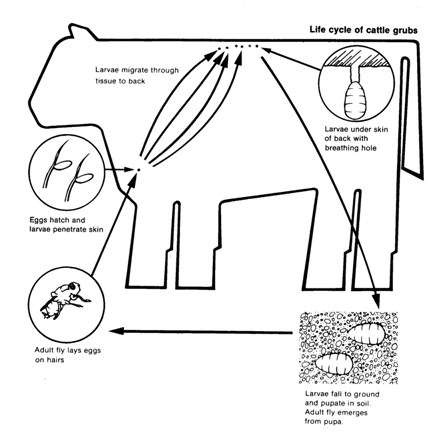Life Cycle and Reproduction
The warble fly lays eggs on the leg of cattle. The eggs are laid onto the leg hairs and are commonly seen in rows of six (Swan and Papp, 1972). A female fly can lay approximately 800 eggs per cattle (Sanchez-Arroyo 2011). The laying of the eggs usually occurs in late spring and early summer (Swan and Papp 1972).
After four to seven days the eggs will hatch and the larvae will crawl out on the skin and penetrate the leg (Merck & Co Inc 2011). This causes great irritation to the cattle. The larvae continue to grow as they travel to the connective tissue from the leg. It will eventually reach the esophageal wall where the larvae will reside in the submucous tissue for the rest of the summer (Sanchez-Arroyo 2011). Here the larvae will grow until it reaches 12 mm (Sanchez-Arroyo 2011).
In January/February the larvae will travel to the dorsal end and reside in the subcutaneous tissue in the back (Merck & Co Inc 2011). A swelling as large as 3 cm in diameters will begin to form directly under the skin (Berube 2007). The swellings are the first sign of the parasite to an outside. The larvae lie in cyst which also contains fluid. They make breathing holes though the skin as well (Merck & Co Inc 2011).
Then again in spring the mature larvae will crawl out of the cyst and fall to the ground (Berube 2007).
When they fall, pupation occurs almost immediately. The pupal case is black and after one to three months, depending on the conditions, the fly will emerge out the covering (Berube 2007). The insect will not mature and come out of the case however if the moisture content is higher than ten percent (Sanchez-Arroyo 2011).
The whole process takes around a year, however the majority of the time is spent in the larvae stage under the skin of the host (Sanchez-Arroyo 2011).
It is important to note that younger cattle are more susceptible and more frequently infected than older animals. It is thought that as the cattle age, that to a certain degree they become resistant against the larvae (Sanchez-Arroyo 2011).
